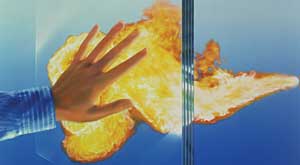Designing with Fire-Rated Glass: Integrating Life Safety, Transparency, and Aesthetics
Multiple Functions of Fire-Rated Glass
Product and technology improvements have resulted in a degree of hybridization, combining multiple characteristics in fire-rated glass. Often, building materials must address several design issues on a project, such as energy conservation, acoustic control, hurricane resistance or security needs. In each case, fire-rated glass products are available to provide additional benefits.
One way this has been accomplished has been through the introduction of fire-rated insulated glass units (IGUs). This enables a tremendous amount of flexibility, since the second piece of glass in the IGU can be virtually any type of product: tinted, coated, or mirrored. The IGUs offer energy code compliance and sound control, which expands the capacity of fire-rated glass beyond containing flames and smoke.
|
Greater attention is being paid to security risks as well. Some fire-rated glazing materials have earned a Level 3 bullet resistance classification, meaning they can stop a .44 Magnum bullet, and greater resistance levels are possible when combined with other glazing products.
Framing Developments
Until recently, fire-rated framing was not keeping pace with innovation in glass products. Using traditional hollow metal steel framing was as predictable a choice as using wired glass. Despite the track record of proven performance, hollow metal doors and frames have limitations.
Hollow metal frames and doors exhibit a bulky appearance due to the method of construction. Rather then being extruded, hollow metal frames are formed from flat sheets of steel, cut to size, then bent into the desired shape. Due to this manufacturing process, hollow metal steel doors and frames lack the crisp edges provided by extruded aluminum systems. In addition, window glass is held in place using glass stops with exposed fasteners. With exposed screws placed approximately every 12 inches to 16 inches, aesthetics are noticeably compromised. The design of hollow metal steel frames makes it difficult to match the appearance of aluminum systems as well. Unlike aluminum frames that sit within a finished opening, hollow metal frames wrap entirely around the surrounding wall.
In the last few years, however, framing options have emerged to allow more aesthetic applications of fire-rated glazing. New types of steel framing systems have been introduced in North America that were previously available only in Europe. Similar in appearance to aluminum storefront framing, these narrow profile frames are nearly extruded from steel tubes, providing aesthetics and performance unmatched by ordinary steel frames. This modern manufacturing process provides a narrower, more streamlined appearance.
For example, 45- to 90-minute rated window frames are often available with a width and depth of less than 3 inches by 2 inches. In addition, door stiles and rails need only be 3 inches wide, rather than 6 inches to 8 inches typically required with hollow metal doors. Further, glass stops use hidden fasteners and the frames install into the wall assembly like a typical aluminum storefront. When finish-painted at the factory, these steel framing systems are difficult to distinguish from ordinary aluminum storefronts. Despite the sleek appearance, tremendous strength is retained in these new systems, because the profiles are formed, rather than bent steel.
New narrow profile "storefront", or floor-slab-to-floor-slab, door and frame systems provide additional design options, and are available with fire ratings of 20 to 90 minutes. As with hollow metal steel, these frames do not provide a barrier to heat transfer. They are most commonly used with thin fire-rated glazing products, like ceramics. Due to their visual appeal, narrow profile doors and frames are sometimes used throughout a building, in fire-rated and non-fire-rated areas, to achieve a consistent appearance.










